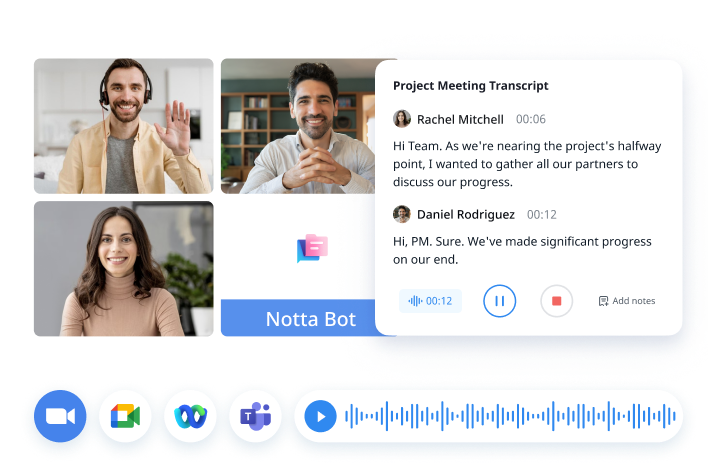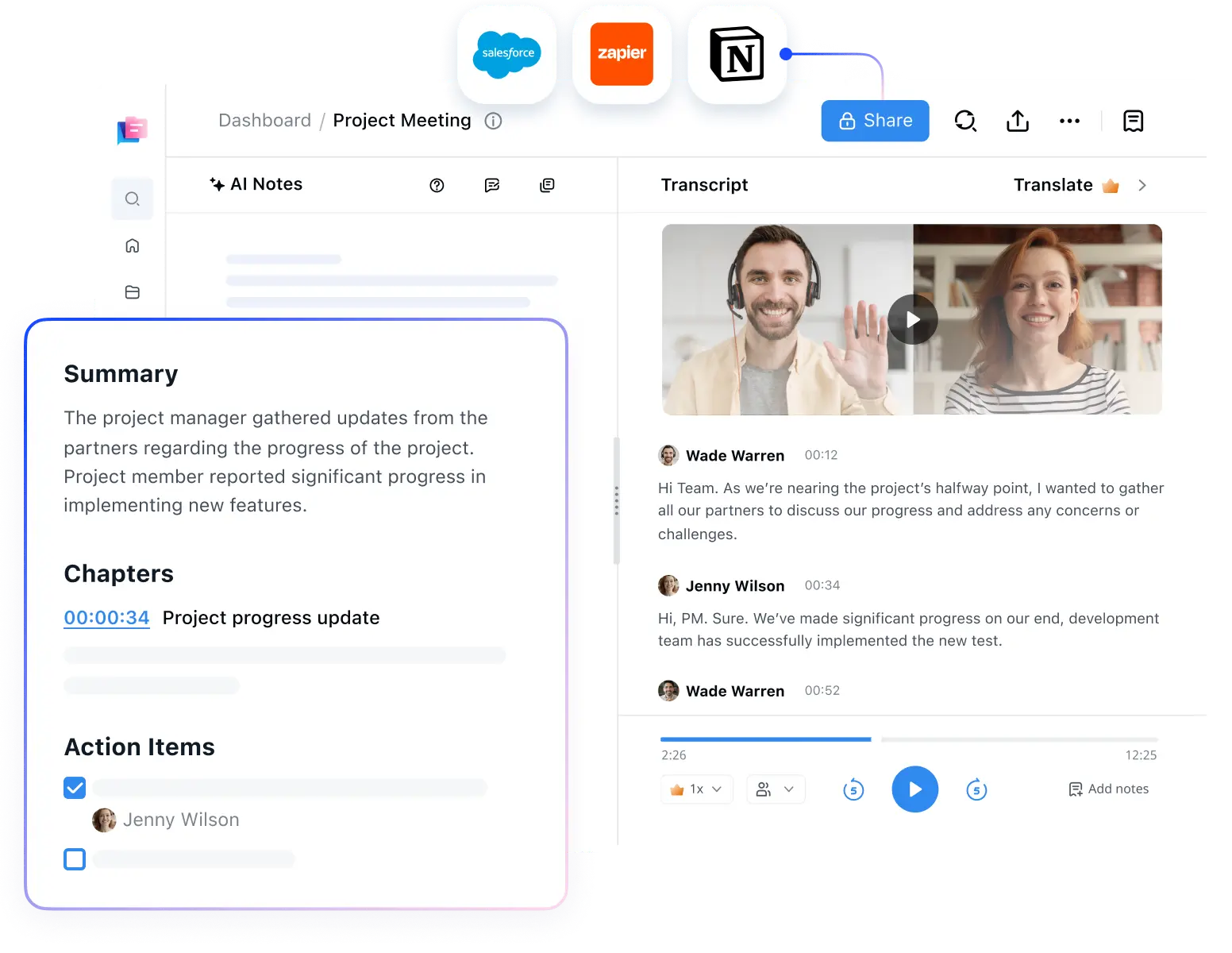
In-Person Meeting vs Virtual: How to Choose
Unlock the power of AI — Notta's meeting assistant records, transcribes and summarizes meeting minutes with one click.
Meetings are essential to the efficiency of any organization, but when the time comes to schedule one, several organizers often contemplate whether to hold an in-person meeting or a virtual one. If you’ve organized one like I have, chances are you’ve faced a similar predicament at some point.
Over the course of my career, I’ve hosted several in-person and virtual meetings, and I’ve come to understand the benefits and downsides of each. In this guide, I’ll take you through the pros and cons of each approach in detail and offer you tips to improve both in-person and virtual meetings to ensure they meet their intended outcomes.
Choose between in-person and virtual meetings
In-person meetings can be a great choice when teams need to discuss sensitive issues that require fewer distractions. On the other hand, virtual meetings are ideal when teams need to address issues in real time, particularly when working remotely.
In-person meetings: Best for discussing complex subjects that require complete attention.
Virtual meetings: Best for remote teams that require greater flexibility without the need to collaborate in person.
| Factor | In-person meetings | Virtual meetings |
|---|---|---|
| Time | They often take more time as teams can often get distracted. | They’re shorter and easier to keep on track. |
| Distance | Employees in different geographical locations can find it challenging to attend. | They cater to remote employees based anywhere in the world. |
| Inclusivity | They’re less inclusive as they only cater to those available at a given point or who speak a similar language. | Virtual meetings bring together globally diverse teams with tools that can help translate speech in real-time. |
| Cost | In-person meetings must cater to the cost of transportation, accommodation, printed material, etc. | Virtual meetings merely require an individual’s phone or laptop, a video conferencing service, and a note-taking tool. |
| Attention | Members’ physical presence helps maintain attention spans for longer. | Members can easily find themselves distracted when attending virtual meetings. |
| Complexity of the topic | In-person meetings make it easier to break down complex topics in one space as one can monitor body language, remain focused, and extend the meeting if needed. | Virtual meetings are best suited to narrower and relatively straightforward topics. |
| Communication tools available | Organizations that lack efficient video conferencing and transcribing tools would do better with in-person meetings. | Virtual meetings are ideal if your organization has a user-friendly video conferencing platform and other tools such as real-time notetaking and translation tools. |
Pros and cons of in-person meetings
It’s important to understand the benefits and drawbacks of in-person meetings to understand the concept. In this section, I’ll discuss the pros and cons of face-to-face meetings.
Pros
First, I’ll take you through the pros of organizing an in-person or a face-to-face meeting with respect to a few key parameters.
Reduced Distractions
Dedicated meeting spaces make it easier for teams to remain focused without distractions such as notifications, emails, phone calls, or other interruptions. This helps each individual remain focused on the meeting’s subject.
Building stronger relationships
In-person meetings help build a stronger bond between team members, thereby building stronger relationships. These bonds often translate to increased trust and greater collaboration during meetings.
Increased engagement
Face-to-face meetings require individuals to refrain from multitasking as they might during virtual meetings. This helps keep each member engaged and facilitates more meaningful contributions to the discussion.
Improved communication
Meeting face-to-face makes it easier for individuals to read each other’s non-verbal cues, such as their body language and facial expressions. These can help provide much-needed context and minimize the likelihood of misunderstandings.
Cons
I’ll now take you through some of the downsides of organizing in-person meetings.
Higher organizational costs
Meeting in person can prove to be far more expensive than doing so virtually. Between the cost of transportation, accommodation for those traveling from far away, refreshments, printed materials, and so on, in-person meetings can prove to be rather expensive.
Requires everyone’s physical presence
In-person meetings require every stakeholder’s physical presence at a given location, which can often prove to be challenging for those who aren’t based locally. This can also make it challenging to schedule meetings at a time convenient for every member.
Difficult to record
In-person meetings often don’t end up being recorded because participants are frequently forced to distract themselves with the process of taking notes. This can lead to concepts being left unclear, affecting the meeting’s outcomes.
Limited flexibility
Given that in-person meetings can be challenging to attend for those located in a different geographical location or for someone with mobility issues, they often end up being less flexible than their virtual counterparts.
Pros and cons of virtual meetings
Just as in-person meetings have their share of pros and cons, virtual meetings also have them. This section explores them in greater detail.
Pros
I’ll start by discussing the benefits of virtual meetings.
Increased flexibility
Virtual meetings ensure geographical barriers don’t come in the way and allow those with mobility issues or other constraints to participate without hassle.
Time and cost-efficient
Virtual meetings don’t require spending on transport, accommodation, meals, and more to cut down on travel time. Thus, the resources saved can be diverted to more crucial operations.
Seamless recording
Virtual meetings can be recorded from start to finish using an AI note-taking tool. These tools can also be used as meeting assistants that can translate and summarize meetings so every stakeholder can be given a list of their respective action items.
Let Notta worry about the details so that you can focus on the meeting. Accurate, real-time meeting notes at your fingertips.
Can be used to respond to needs in real-time
Virtual meetings are ideal in situations where teams must respond to situations in real-time. They don’t require aligning everyone’s schedules and having them in the same place at the same time.
Cons
After discussing the benefits of online meetings, let’s examine their potential downsides.
Lack of personal connection
Virtual meetings rely on everyone sitting behind a screen, reducing the possibility of members interacting in person and fostering healthy, professional relationships with one another.
Potential for distraction
Digital distractions can often prove to be a barrier to keeping individuals engaged during virtual meetings. The constant buzzing from emails, notifications, or other distractions in one’s immediate environment can lead to reduced engagement.
Can lead to ‘Zoom fatigue’
Given that a lot of one’s work involves looking at a screen, virtual meetings can often exacerbate what’s referred to as ‘Zoom fatigue’ - a sense of burnout from the increased cognitive demands of virtual work.
Potential technical difficulties
We’ve all experienced technical glitches like frozen videos, unstable internet connections, and echoing audio - these often hamper the efficiency of meetings, leading to rescheduling, which can create a sense of frustration.
7 tips to improve your in-person and virtual meetings
In this section, I offer you seven key tips that you can rely on to improve all your meetings — whether they’re conducted virtually or in person.
Encourage openness and transparency: Practicing active listening and offering constructive feedback and advice can go a long way toward building a sense of comfort that leads to open and transparent communication. This can go a long way in breaking the ice and making meetings a lot more effective.
Keep in-person meetings focused: In-person meetings often tend to get sidetracked. It’s crucial that you set a clear agenda and ground rules for every meeting to avoid the time wasted on small talk.
Build personal connections: Face-to-face meetings offer members the advantage of building personal connections. Be it in the form of facing the speaker, using approachable body language, and responding non-verbally to their input, you can help foster a sense of free and open communication.
Record virtual meetings: Using an AI notetaker is crucial to ensuring virtual meetings meet their outcomes. They help record every aspect of the discussion, transcribe them, and even summarize them so every member has a clear understanding of what’s discussed. A tool like Notta can automate every step to ensure you get a comprehensive overview of the discussion.

Follow virtual meeting etiquette: Ensure you check your internet connection, mute notifications or turn on Do Not Disturb, and keep your microphone on mute when not speaking — these are a few etiquette tips that can help make virtual meetings much more efficient and respectful.
Share notes and action items right away: Since virtual meetings often end without coworkers discussing the subject any further, they might forget key details with time. As a result, you must share any action items and notes with the group as soon as the meeting ends to ensure everyone is on track with their priorities.
Assign individual roles beforehand: Assigning individuals key roles such as the facilitator, notetaker, and so on can help keep the group engaged and ensure everyone pays keen attention to the discussion.
Key takeaways
Every organization runs differently, and with these differences comes a choice between in-person meetings and virtual meetings. Both approaches have their own share of benefits and downsides, which I’ve explained in this guide.
While in-person meetings can be ideal when the subject matter is rather complex, virtual meetings offer teams greater flexibility. Regardless of your approach, however, it’s crucial that your meetings are documented, particularly if they’re conducted virtually.
With an AI note-taking tool like Notta, you can automate the complete process of recording and transcribing meetings from start to finish. It can also translate these transcriptions into over 50 languages and summarize the discussion for you so that every meeting achieves its outcomes. Visit the Notta website to see how you can make your meetings a lot more effective!

FAQs
Is meeting in person better?
While virtual meetings can offer immense flexibility and accessibility, there’s no doubt that in-person meetings help foster stronger relationships and prove to be immensely effective when discussing complex subjects.
How do you prepare for a face-to-face meeting?
There are a few key aspects to consider when preparing for face-to-face-meetings:
Set a specific goal as the intended outcome of the meeting.
Prepare a detailed agenda to keep the meeting focused.
Create a clean, organized space to ensure greater focus.
Present yourself professionally.
Arrive early to break the ice with the other participants.
What are the benefits of virtual meetings vs in-person?
Virtual meetings offer a host of benefits: they offer more flexibility for those who work remotely, eliminate the need to travel, save on costs, and make it easier to collaborate during emergencies.